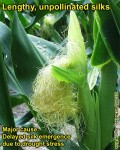

![]() ot unexpectedly, silk emergence has been delayed in some
drought-stressed corn fields throughout the state. Lengthy silk emergence
delays relative to pollen shed disrupts the pollination process, resulting in
ears with varying degrees of barrenness. What caught my eye this week in
several fields was the appearance of ears with unusually long fresh
(unpollinated) silks.
ot unexpectedly, silk emergence has been delayed in some
drought-stressed corn fields throughout the state. Lengthy silk emergence
delays relative to pollen shed disrupts the pollination process, resulting in
ears with varying degrees of barrenness. What caught my eye this week in
several fields was the appearance of ears with unusually long fresh
(unpollinated) silks.


One of the consequences of severe drought stress near pollination is a delay in silk emergence. Sometimes the length of the delay is great enough that little to no pollen remains in the tassels by the time the silks finally appear.
The good news is that unpollinated silks will continue to elongate for about 10 days after they first appear from the ear husks before they finally deteriorate rapidly. The bad news is they do become less receptive to pollen germination as they age and the rate of kernel set success decreases towards the end of the 10 days.
Unusually lengthy silks that are still “fresh” during the pollination period are therefore a symptom that pollination has not been successful. Drought-stressed fields exhibiting visibly long fresh silks should be inspected for possible pollination failure.
I recently described the “ear shake” technique for evaluating silk detachment to verify the extent of pollination success soon after pollen shed is complete. It doesn’t take long to check a number of ear shoots for silk detachment. Also look at the tassels for evidence of anthers and pollen yet to be released.
If the “ear shake” technique indicates that little successful pollination has yet occurred AND if there is little visual evidence that pollen remains in the tassels, then the prospect for complete kernel set on the ears is unfortunately very dismal. If, on the other hand, there appears to be pollen yet remaining in the tassels, then the opportunity still exists for some degree of kernel set.
 For other
information about corn, take a look at the Corn Growers Guidebook on the World
Wide Web at http://www.kingcorn.org
For other
information about corn, take a look at the Corn Growers Guidebook on the World
Wide Web at http://www.kingcorn.org